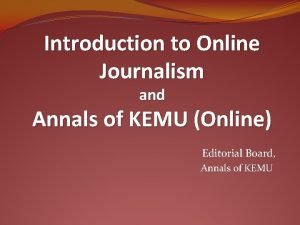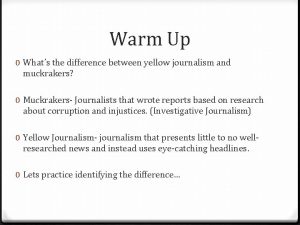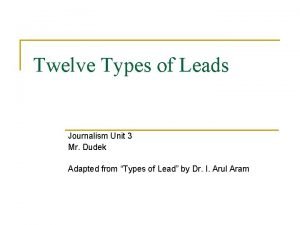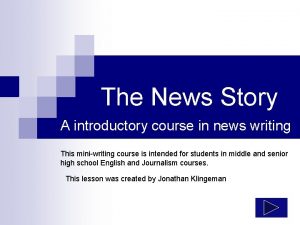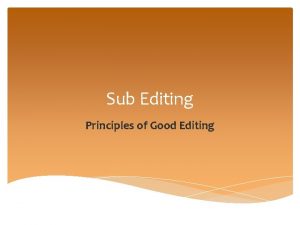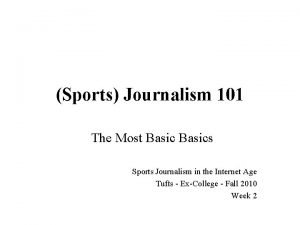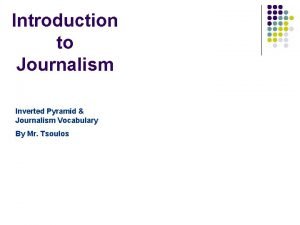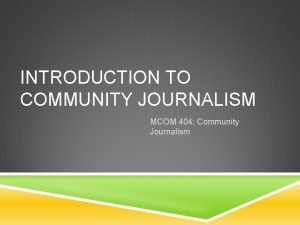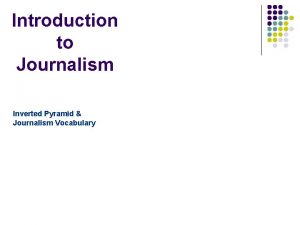Introduction to Journalism What is journalism n It














- Slides: 14

Introduction to Journalism

What is journalism? n It is reporting and writing the news and packaging it for an audience.

Where can you find the news? Newspapers n Magazines n Internet n TV n Others n

Primary Roles of Publication (In no particular order) n News Reporting—a high priority in a broadcast or newspaper, but a low priority in a magazine or yearbook. You have to decide what is news worthy. n Entertainment—questionable in any setting —do you want to entertain your readers more than inform?

Con’t n Matter of Record—a high priority in a yearbook n School Spirit—do you want to promote your school through publication? n Community Image—should you focus on adults in the community who may read your publication, or try to stay focused on the students?

Con’t n Educational Skills—should you focus on what you’re learning and perfecting your skills, or the product? n Reader Culture—what type of reader should you publish for? n Leadership—should you just report the news or use voice in your publication?

Con’t n Public Forum—should you use input from non-staff members in the forms of guest columns and letters to the editor? n Interpretation—explain the environment around you.

What do we want? n n n News Reporting Entertainment Matter of Record School Spirit Community Image n n n Educational Skills Reader Culture Leadership Public Forum Interpretation

Journalistic Models

Advocacy Model Provides news from the perspective of a political party n This model defined journalism until the beginning of the 20 th century, but faded out as political parties lost power and masscirculation newspapers developed n It still exists in things such as magazines for special interest organizations, and newsletters n

Market Model Provides whatever kind of journalism the audience demands because what is newsworthy is determined by advertising n The content is selected here only to make money n Think tabloids n

Trustee Model Journalist determines what the audience needs to know and delivers n Based on the point that the reader or viewer does not have the time or skill to find out everything that is happening, so they trust in the reporter to do so. n

Six types of Audiences: Mainstream: reads local newspapers, watches local news, is interested in sports and crime, but not foreign news n Basically Broadcast: gets most news from local TV and networks such as prime-time “magazines, ”; enjoys health, community, and crime news n Very Occasional: tunes in only when something big is happening, (heavily male audience) n

Con’t Constant: watches, listens to, and reads almost everything; likes all topics n Serious News: relies heavily on National Pubic Radio, News. Hour, Wall Street Journal, etc. ; likes news and business magazines n Tabloid: rejects traditional broadcast news; favors the National Enquirer, tabloid TV, and tell-all talk shows n
 Literary journalism vs traditional journalism
Literary journalism vs traditional journalism Literary journalism vs traditional journalism
Literary journalism vs traditional journalism Annals kemu
Annals kemu Body paragraph
Body paragraph Yellow journalism style
Yellow journalism style Staccato lead journalism examples
Staccato lead journalism examples Muckrakers definition
Muckrakers definition Types of novelty lead and examples
Types of novelty lead and examples Inverted pyramid headline example in newspaper
Inverted pyramid headline example in newspaper What is anecdotal lead
What is anecdotal lead It is an introductory section of a news story
It is an introductory section of a news story The sub editor
The sub editor Journalism basics
Journalism basics Deck journalism
Deck journalism Importance of rural journalism
Importance of rural journalism


